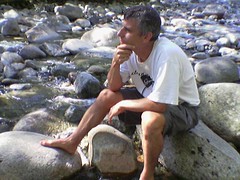March 29, 2006
Digg is to Slashdot, as Reddit is to Kuro5hin
After very careful consideration, I've come to the conclusion that my current understanding of Digg and Reddit can be expressed in the form of an SAT analogy and terms of a pair of "community" sites from the previous generation.
Digg is to Slashdot, as Reddit is to Kuro5hin
Yeah, I kinda gave it away in the title of this post, didn't I?
Oh, well.
Now, I suppose you want evidence for this odd claim.
Unfortunately, a lot of it boils down to qualitative things: the "feel" of each site and the type of content that surfaces there most often. Slashdot and Digg are tech heavy, while Kuro5hin and Reddit seem to cast a wider net that captures more of science and culture (and occasionally some politics).
Slashdot and Digg both drive a lot of traffic and experience a lot of churn, while Kuro5hin and Reddit are a bit more stable and have smaller (but by no means "small") audiences.
See also: Because You Asked which takes a cursory look at one site's experience appearing on both.
Thoughts? What other similarities do you see, assuming you've been a user of or participant in each of them for a non-trivial amount of time?
March 27, 2006
How to revamp Yahoo! Groups?
I've been thinking a lot about Yahoo! Groups recently. This is partly because I'm a member of more than 30 mailing lists hosted there. But it's also because I find myself running into limitations that seem pretty silly in 2006. More importantly, I feel like Yahoo Groups can serve as the collaborative (not just communications) platform for bringing people together in interesting ways.
There are bits of JotSpot (notable Tracker), WordPress, and Flickr that I think could be sprinkled into Yahoo Groups, not to mention Google Maps and/or Wayfaring, Yahoo! Local, Google Calendar, and a few other things.
This definitely means thinking about Yahoo Groups as more than place to host a free mailing list, which is how most people use it today.
But before I ramble on too long, I'd like to know how you would like to see Yahoo! Groups evolve. What's missing? What killer applications or add-on services deserve to be part of the service? Are there alternative services that are providing a lot of this already?
March 25, 2006
Bacon Waffles
After a brief overnight trip to Houston, Texas, I met up with some friends from Rhode Island in San Francisco today. They needed to get from there to their hotel near SFO, so I went up to fetch them and stop for some good brunch along the way.
We visited Stacks, one of my favorite breakfast places. We hit the one in Burlingame, which I'd never been to. I've eaten at the Stacks in Redwood City a few times, and there's one in Campbell, just a few miles from where I live (see locations).
Browsing the menu, I discovered that they've fused two of my favorite breakfast foods: bacon and Belgian waffles.
Not knowing quite what to expect, I ordered a "bacon waffle" and side of scrambled eggs. When the food arrived, it turned out to be everything I hoped it might: an amazing Belgian waffle with many bits of bacon strewn about inside. Just add syrup and enjoy.
To whoever thought to put the bacon inside the waffles, I thank you.
March 24, 2006
Dear Valleywag
Slow "news" day, was it?
You managed to mention me twice (here and here) in the past week, thereby ensuring that I'd end the year failed in my stated goal of "not appearing on Valleywag." (Perhaps I shouldn't have mentioned that to Scoble at SES.)
Seriously... While I admire your attempt, you really do need to try harder. A quick survey of friends and co-workers found that most weren't terribly amused. I also wasn't amused. But more importantly, you didn't even come close to offending me.
You call yourself a "tech gossip rag?"
I think we're all really hoping for something that's more like a cross between the Weekly World News and The Onion.
But this is just kind of lame. The whole "let's cram two pictures of people next to each other and try to make it funny" thing is below you.
Please tell me you've got something Really Good planned for April 1st.
March 23, 2006
The Flip Side
I knew it would happen. Someone would latch onto my story about Yahoo! Finance and extrapolate to the whole company. It's human nature.
Henry Blodget writes, among other things, the following:
Perhaps the enormous success the company achieved in its first five years has permanently infiltrated its DNA. Perhaps the first thing every Yahoo thinks when he or she wakes up every morning is "I am a Yahoo! I am rich, brilliant, and cool. Now, let's see where I'm having today's four-hour lunch." Perhaps what motivates Yahoos these days is dreams of more visits from such inspirational business leaders as Tom Cruise ("My manager told me that next year Terry's working on Tom Hanks!"). Perhaps the secret fantasy of many Yahoos is that, someday, they'll finally be cool enough to be invited to the Oscars.
It's so tempting to do that--to use my example as evidence for all of Yahoo being doomed. We all like to simplify and generalize.
But the reality is that there's a ton of cool stuff going on here. Many groups are kicking ass, releasing great products, and getting users excited. The stuff I rant about is what particularly bugs or excites me. It's a look into slices of what's going on around here, but it's hardly a representative sample.
Yahoo! Messenger now has voice calls with prices lower than Skype. Yahoo! Music Engine is still hard to beat if you're not of the iPod cult (sadly, I am). The new Yahoo! Mail still has a line of people waiting to get in, and it's not even done yet. There's a ton of great stuff coming out of the Search groups. In fact, you're going to hear more about it very, very soon. Heck, even the home page may get a new look.
I was just talking to Tom a few minutes ago about how hard it is for people outside a large organization to understand that there are many different realities in existence on the inside.
What motivates most Yahoos I know is trying to make cool stuff: products and services that their friends, family, and pretty much anyone wants to use. That doesn't mean it's always gonna be an easy ride. Most Yahoos weren't here five years ago, so I don't buy much of that DNA argument.
The day I start thinking we're doomed is the day I start looking for another job.
March 22, 2006
Why Google Finance Makes Me Sad
I've had several folks ask me what I think of Google Finance. There's already a fair amount of good commentary out there on the topic (Bambi, TBAiT, Charlene, Matt, Publishing 2.0, Blodget, and others), so I'm going to answer this in a different way.
Warning: This is long and not terribly flattering stuff that's been under mild pressure for a few years now.
You see, I started at Yahoo! back in 1999 as an engineer working on Yahoo! Finance. It was one of the sites I used most often back then, so it was a privilege to get my hands on it and really contribute in a meaningful way. I spent roughly the next three years working with the good folks in our group, including Katie Stanton, who announced Google Finance a few days ago.
Katie was one of the best people we had in Yahoo! Finance. I was disappointed when she left Yahoo a few years back. I remember chatting with her a few times when she decided to go back to work. Trying to choose between Yahoo and Google, she asked for opinions.
How time flies...
Last year I teased her a few times about Google Finance. Of course, she denied that any such thing was in the works. Since I knew it was in the works, I wasn't surprised when it finally came out. Nor was I surprised to see her affiliated with the product.
It clearly has a Yahoo! Finance feel in several areas but with a distinctly Google flavor to it. I have minor complaints about it, but I think it's a good start aside from the fixed width home page.
Sadness
So why does this make Jeremy sad?
It makes me sad because I end up thinking about how Yahoo! Finance has stagnated for a long time. It never really recovered from the pain of the dotcom crash. So many of my old Finance coworkers have either left the company or moved on to other groups (several moved into Search last year). Heck, I encouraged many of them to get out!
There was a lack of leadership and, even more importantly, a serious LACK OF VISION. It really disappointed me.
It makes me sad because virtually all of the new/innovative/cool features in Google Finance are things we talked about YEARS ago. Many of them I'd lobbied for repeatedly. Some were even prototyped.
- A ticker search that doesn't suck.
- Charts with overlays for news events.
- Blog integration.
- Featuring discussions more prominently.
- RSS support.
Who's gonna get "credit" for all that now?
I'm not gonna name names (virtually none of them are around anymore anyway), but there was a real lack of leadership in Finance for long time and it really sucked the life out of the group. Users noticed. Finance employees noticed. Other Yahoos noticed. We all knew it. And, frankly, I was glad to be out when I moved on (and the next time and the time after that).
Over the years since leaving, I've made pleas to numerous people in the Finance organization: engineers, product managers, engineering managers, editorial, and so on--veteran employees and newbies alike.
Push into community more. Get more into personal finance, not just the high-end Wall Street stuff. Adopt blogging and syndication. Get around to those chart improvements we'd talked about. Fix up the message boards. (Remind me to tell the story of how they freaked out when I snuck RSS feeds out back in 2002. It took another TWO YEARS before someone re-did that work and finally shipped it. But the RSS train had already left the station by that time.)
Radio silence.
Last year I started talking about Google Finance and they got a little excited. They talked more about all the stuff they could maybe do. Asked for some input (again). My hope was renewed for a while.
During all that time, I purposely didn't write anything here about my frustration and disappointment. I've been accused of using my writing in public as a instrument to instigate internal change at Yahoo. I've been accused of complaining in public before talking to folks internally. So I tried to be a good Yahoo and give my suggestions to anyone who'd listen.
On the other hand, people tell me they like reading my stuff because it's not sanitized corporate PR speak and I'm not always painting a rosy picture of what goes on. Instead, I tell it like it is--from my point of view, of course.
Well, here we are.
As a company, we need to get better about facing this stuff, dealing with it, and get back to kicking ass. But I have no idea how to make that happen. Maybe this will result in some useful discussion somewhere.
There's a light at the end of the tunnel. All hope is not lost. Unlike a small number of Google product launches, this one didn't blow the doors off. It's no Gmail or Google Maps. Yahoo! Finance isn't out of the game. But I sure as hell hope this is a wake-up call!
On the flip side, Katie's a kick-ass product manager and knows the Finance world very well. I can only imagine what else they're cooking up. The clock is ticking.
See Also
- Josh Woodward's take (he and I worked together for a few years on Y! Finance)
(Remember: I'm not speaking for my employer... yada, yada, yada. See the disclaimer at the bottom of the page.)
March 21, 2006
FAA High Altitude Training and Chamber Flight at Beale AFB
Today I took the day off work to attend one of the FAA sponsored high altitude physiology training classes. They're offered at about a dozen locations around the country, the nearest to me being Beale Air Force Base northeast of Sacramento.
Though about eight or ten people has signed up and pre-paid $50 for the class, only two of us showed. The other was a guy named Dale who is also a glider pilot flying from Byron with NCSA. That meant the training was, shall we say, highly personalized. :-)
 Beale AFB is home to the U2 spy plane, one of the oldest and most impressive military aircraft still flying.
Beale AFB is home to the U2 spy plane, one of the oldest and most impressive military aircraft still flying.
Part of the fun of being on the base, aside from getting lost, is watching the U2s fly around. They look like big old gliders with F-16 engines in them. And that's not too far from the truth. There were several practicing approaches while we were there, but we also got to watch one going on a "high flight" (above 45,000 feet) take off and climb out of sight while making a hell of a lot of noise.
 The first thing we really did was get fitted for our helmet and oxygen mask. I'll likely never wear a helmet like that when flying, but I do have a mask that costs several thousand dollars less that the military training model I was using.
The first thing we really did was get fitted for our helmet and oxygen mask. I'll likely never wear a helmet like that when flying, but I do have a mask that costs several thousand dollars less that the military training model I was using.
After that, the morning instruction began. We spent a lot of time reviewing the specifics of pressure changes with altitude increase, how that affects oxygen absorption in the bloodstream, and so on. We covered related matters like G forces, disorientation, low lighting and night flying, etc.
A far amount of it was review, but there was a lot of new stuff included too.
 After lunch we watched a quick FAA video on oxygen systems and then headed to the chamber.
After lunch we watched a quick FAA video on oxygen systems and then headed to the chamber.
The chamber at Beale has 18 seats in it. Two are always in use by military observers who are there to help with the training and make sure nobody gets hurt. Each seat has an oxygen control console, a "walk around" emergency bottle (the yellow ones), and a clipboard with some mental exercises on it.
 Our routine for the afternoon was to perform a test ascent to 5,000 feet and make sure that nobody has sinus or ear problems. Once back at ground level, we'd go on 100% oxygen for 30 minutes while listening to a more detailed lecture on oxygen systems and depressurization (both rapid and slow). The 30 minutes on pure oxygen gave our bodies time to get rid of a fair amount of nitrogen gas.
Our routine for the afternoon was to perform a test ascent to 5,000 feet and make sure that nobody has sinus or ear problems. Once back at ground level, we'd go on 100% oxygen for 30 minutes while listening to a more detailed lecture on oxygen systems and depressurization (both rapid and slow). The 30 minutes on pure oxygen gave our bodies time to get rid of a fair amount of nitrogen gas.
Once that time was up, we ascended to 8,000 feet and were asked to remove our masks for a bit. Then we simulated a rapid ascent from 8,000 to 18,000 feet without oxygen.
 From there, we put the oxygen back on and ascended to 25,000 feet where the real fun began. At FL250, we removed our masks and then worked on the mental puzzles on the clipboard, all the while monitoring ourselves for the onset of hypoxia.
From there, we put the oxygen back on and ascended to 25,000 feet where the real fun began. At FL250, we removed our masks and then worked on the mental puzzles on the clipboard, all the while monitoring ourselves for the onset of hypoxia.
I was able to do maybe a minute of the questions before I started to feel myself getting stupid. And as I looked around the chamber, I noticed that my vision wasn't working so well. Finally, I just started to feel odd. The rule was that we'd put our oxygen systems on the "emergency" setting and put the mask back on after noticing three symptoms, so I did.
Wow! I noticed right away how much my vision improved. I hadn't really realized the extent to which it had diminished until I witnessed the recovery. It was shocking.
After our fun at 25,000, we descended back to 18,000 and removed our masks once again. This time they lowered the lights to simulate night flying and asked us to stare at a color wheel. The idea was to notice our peripheral vision decreasing and the nearby colors all blending together. I did notice the color blending but not much of a decrease in peripheral vision. Again, when I went back on pure oxygen, I immediately noticed a dramatic improvement.
 After a final summary and some paperwork, our training was complete. We then got the chance to go watch a U2 pilot getting suited up for a high altitude flight and learn about the suits they wear.
After a final summary and some paperwork, our training was complete. We then got the chance to go watch a U2 pilot getting suited up for a high altitude flight and learn about the suits they wear.
The process of getting dressed was complex. It required a team of people to help him get the suit on, hook up, test the systems, and so on. I could write a lot more about what the U2 pilots go through but it's getting late. Suffice it to say that I have a new found respect for those guys.
Pictures are in my Chamber Ride set on Flickr.
March 20, 2006
MIX06 Thoughts
As previously noted, I'm at Microsoft's MIX06 conference right now. Sadly, I can only be here for the day due to scheduling problems.
I just finished the panel discussion ("Web 2.0: Show Me The Money") in which I got to hang out on stage with Tim O'Reilly, Michael Arrington, Adam Trachtenberg, and Royal Farros and talk about all sorts of things around what Web 2.0 is, where money is made, and so on.
The panel seemed to go well. It took a bit of time before the audience started to ask questions, but once they did it never stopped.
The weirdest thing about this conference is that nobody is quite sure who is in the audience. It's not your typical Microsoft conference aimed squarely at developers. It's not quite an O'Reilly Web 2.0 conference. It's just... different. The audience is a real mixed bag and that's okay. It just makes things a bit harder to predict.
I'm anxiously awaiting lots of other postings from attendees so that I get a better sense of what people think and what I'm missing in the next few days.
I tried to find a photo of our panel (I know many people were snapping pics) but don't yet see one on Flickr. At least there isn't one tagged with mix06 yet.
March 19, 2006
Freecycle and On-Line Local Community Software
On Friday, Jon Udell came to visit Yahoo and give a longer version of the presentation he delivered at this year's ETech conference. While it was thought provoking and something I'll likely write more about later, we had some fun discussion later that day around on-line software that helps real-world local communities--those who are physically close to each other in the real world.
I talked a bit about my neighborhood mailing list, which is primarily a vehicle for sharing and soliciting recommendations for contractors, places to eat, and so on. Jon talked about chats with the editor of his hometown newspaper and its role in local citizen journalism. Chad talked about trying to get a good plumber in Berkeley. The example I never thought to bring up is freecycle, which is a sort of on-line giving and receiving network.
The Freecycle Network is made up of many individual groups across the globe. It's a grassroots and entirely nonprofit movement of people who are giving (& getting) stuff for free in their own towns. Each local group is moderated by a local volunteer (them's good people). Membership is free.
That's the high-level view. How does it work?
When you want to find a new home for something -- whether it's a chair, a fax machine, piano, or an old door -- you simply send an e-mail offering it to members of the local Freecycle group.
Or, maybe you're looking to acquire something yourself. Simply respond to a member's offer, and you just might get it. After that, it's up to the giver to decide who receives the gift and to set up a pickup time for passing on the treasure.
In other words, this is the simplest thing that could possibly work. My local freecycle group, sanjosefreecycle is just a lightly moderated Yahoo! Group that anyone can sign up for and then offer or request items. So far I've given away and old computer and an ironing board.
People are asking for all kinds of things: shoes, microwaves, chairs, you name it. There's absolutely no money involved. And it works amazingly well. With nearly 5,000 members, one can see why.
Simple Lessons
I think there are many lessons in Freecycle for those trying to build services used by "normal people" in local communities. The first is simplicity. A mailing list is the simplest thing that could possibly work. No web site that hosts photos of offered goods, no bidding process, etc. It's simply email.
Moderation is also important. That is, giving someone the flexibility and control necessary to exercise their own judgment and enforcing rules and customs that can't be baked into the software. In this case it comes in the form of a group moderator who can edit, revise, approve, or reject messages crossing the list. The result is that there's no spam, self-promotion, or commercial interests devaluing the list.
March 17, 2006
In Defense of Web Developers, Again
Almost exactly a year ago, I wrote a blog post titled Respect for Web Developers in which I said:
That last point it worth reinforcing. I think a lot of people who've been doing "web stuff" long enough think that web developers are the same as the "HTML monkeys" we use to refer to back in the day. That couldn't be farther from the truth.
Sadly, the attitudes I was hoping to nudge into changing continue a year later.
In response to my call for resumes on the Yahoo! Search blog, David Utter at WebProNews said a few things I don't agree with.
However, we are likely to hear from readers who will point out one thing immediately about all of these positions - they do not appear to be true engineering or programming jobs, which means the pay scale will be lower than those fields. They do not require, or even create the perception, an advanced degree in computer science is needed.
Referring to web development as "front-end engineering" is very generous. While web development involves coding, PHP and AJAX aren't exactly the same as C++ or Java.
Sigh...
I agree that PHP and AJAX aren't exactly the same as C++ or Java (duh), but that doesn't mean they're less demanding. Some of the smartest people I know are kick-ass Java or C++ developers. But another slice of them are amazing front-end engineers. They understand JavaScript, DOM manipulation, cross-browser scripting, PHP, XML, state management, and so on.
The undercurrent in what Dave wrote is that front-end engineers are lesser engineers than those working on the back-end. That says more about his ignorance of the challenges in developing (and releasing) world-class front-end code that works for millions of users.
I happen to think the Yahoo! User Interface Library and Yahoo! Design Pattern Library are good examples. Everybody who mentions them to me (including the previously mentioned Y Combinator startup guys) is gushing about how much time they save, how well they're constructed, and how they're great examples of front-end engineering.
In the Yahoo! world, these front-end engineers actually report up through our engineering organization. It's not just a glorified label we slap on them to make 'em feel good.
This stuff isn't monkey work. It hasn't been for a long time. Can we move on yet?
Startups, Y Combinator Style
In the last week I've had the chance to play with a few new services that have begun to appear:
- Pixoh: an on-line photo editor
- YouOS: a web operating system
- Wufoo: a web-based form builder and data collection/reporting service
All three were born out of the desire to solve existing real-world problems. And they've all been brought from idea to working prototype in the last few months by very small teams of people (4 or less). They're working under the guidance and funding of Y Combinator, the Paul Graham, Trevor Blackwell, and Robert Morris created startup incubator in Mountain View.
Each of those services manages to offer something easy to use that's also groundbreaking in one or more ways. However, this isn't inatended to be a detailed review of any. I'll save that for later.
Last night I had the opportunity to spend a few hours at their office meeting with the founders, watching product demos, and exchanging ideas about how they could expand and improve their services. I also spent a bit of time watching Trevor's latest robot creations, including the self-balancing robotic Segway. Cool stuff. ;-)
I had a great time and was impressed by the drive, energy, and creativity of the young entrepreneurs present. I wouldn't be at all surprised if we end up hearing a lot more about them in the coming months as their products become more public and further refined.
Thanks to Paul and others for the chance to drop by and hang out!
March 16, 2006
Aggregated Diminishing Returns and a Feed Diet
It's easy to get sucked into things. You can sit down with a good book for a few minutes and before you know it, several hours and a few hundred pages have gone by. It happens to all of us now and then.
My allocation of time spent reading RSS feeds and various blog or social web sites (Digg, Reddit, TailRank, Memeorandum, del.icio.us) has always been a bit slippery. I'd simply read until I was done reading. I had to make sure all those folders and feeds were un-bolded before I was "done." And every once in a while, the periodic update would run before I finished, and I'd end up with even more work to do. The horror!
I spent some time thinking hard about that use of my time yesterday and realized that it's a classic example of diminishing returns. Since I almost always read that stuff in my own "priority order" I get the most bang for my time in the first 15 minutes or so. Beyond that, I'm panning for gold and it feels like the supply is dwindling. Another 10 minutes spent reading about the latest Dave Winer drama is hardly a good use of my time.
I remember reading about Robert Scoble's reading habits a while ago. He'd spend 3-5 hours every day reading his 1,500+ feeds, also panning for gold. That seemed insane to me then (and still does). But I've been doing the same thing, albeit in a less extreme way.
So it's time to change my habits--or at least form new ones. For the next two weeks I'm allocating 30 minutes per day to this reading, trolling, and mining effort. There's no pre-set limit on how much time I'll spend writing. The returns associated with writing appear to be quite different.
What will I do with that extra time?
I'll spend the "work" time coding a new idea and battling the inbox. I'll spend the "home" time studying for my upcoming FAA written test.
Someday someone will pull all this ranking, customization, personalization, recommendation, and other magic technology together and give me a great reason to throw out my RSS Aggregator once at for all. Until then, I'm going on a Feed Diet.
March 14, 2006
Social Engineering in Cal vs. USC Basketball Game
Bruce Schneier brings us the tale of a most excellent social engineering tactic that some students at Berkeley used to distract USC's Gabe Pruitt:
Victoria was a hoax UCLA co-ed, created by Cal's Rally Committee. For the previous week, "she" had been chatting with Gabe Pruitt, USC's starting guard, over AOL Instant Messenger. It got serious. Pruitt and several of his teammates made plans to go to Westwood after the game so that they could party with Victoria and her friends.
You can see where this is going, right? I couldn't...
On Saturday, at the game, when Pruitt was introduced in the starting lineup, the chants began: "Victoria, Victoria." One of the fans held up a sign with her phone number.
Oh, no! Now the sheer brilliance of the plan shines...
The look on Pruitt's face when he turned to the bench after the first Victoria chant was priceless. The expression was unlike anything ever seen in collegiate or pro sports. Never did a chant by the opposing crowd have such an impact on a visiting player. Pruitt was in total shock. (This is the only picture I could find.)
The chant "Victoria" lasted all night. To add to his embarrassment, transcripts of their IM conversations were handed out to the bench before the game: "You look like you have a very fit body." "Now I want to c u so bad."
Wow, that's one of the best social engineering stories I've read in quite a while.
Be careful who you chat with, boys and girls. It's a crazy world out there.
Congrats to the folks at Cal Berkeley for coming up with an innovative use for AIM. :-)
Quote of the Week: Ev on MSN Branding
This made me laugh out loud... and then cry:
One of the sponsors of SXSW is apparently something called MSN Video Windows Live Spaces. It's on all the banners and signage as a hodgepodge of logos and brands all put together. I'm, like, huh?
It reminds me of failed attempts to change the name of "Y!Q" to something that people could actually figure out.
Is it "Yahoo! Q"? Or "why queue"? A weird play on IQ? And what does it do, anyway?
Performancing Blog Metrics Launches
 Nick has just announced the availability of Performancing Mertrics, which he describes as "a professional grade blog statistics service aimed at professional bloggers."
Nick has just announced the availability of Performancing Mertrics, which he describes as "a professional grade blog statistics service aimed at professional bloggers."
I was invited into the closed beta test but unfortunately didn't find the time to set it up on my site. I ran Google Analytics for a month or so but quietly removed it a while back. While there was some interesting data porn, I didn't actually need it or the performance penalty that came with running it.
If their Firefox extension is any indication, I suspect that Performancing Metrics will rock too.
Doug Cutting is a Yahoo!
I kinda suspected this day might come:
...after four years as an independent contractor, I accepted a full-time job with Yahoo!. This isn't as big of a change as it sounds. For much of the past four years my work on Nutch had been in-part funded by Yahoo! (and Overture before they were acquired by Yahoo!). I'm still primarily working from home, and, so far, entirely working on open-source stuff: Lucene, Hadoop and Nutch.
Welcome aboard, Doug!
Backups, On-line Storage, and Stupidity
We're living in interesting times. With today's release of Amazon.com's S3 on-line storage service, we're one step closer to the cheap on-line storage that so many don't believe will be useful.
Amazon S3 provides a simple web services interface that can be used to store and retrieve any amount of data, at any time, from anywhere on the web. It gives any developer access to the same highly scalable, reliable, fast, inexpensive data storage infrastructure that Amazon uses to run its own global network of web sites. The service aims to maximize benefits of scale and to pass those benefits on to developers.
Amazon's initial pricing is $15 for 100GB/month. Objects in the store can range from 1 byte to 5 gigabytes and you can store an unlimited number of them. Interestingly, this service is offered by "Amazon Digital Services, Inc." which must be an A9-like subsidiary of Amazon.com.
In related news, some guy had 300MB of "CRUCIAL data" stored in Gmail and found his account deleted. He had no backups and claims that he "fell victim to Google." He ends by asking for advice because "this is an emergency for me."
How about getting a clue? All I can think is "what kind of dipshit doesn't backup his CRUCIAL data?!" Seriously. Gmail is a free beta service.
Thankfully, more than a few people in the forum comments are pointing out what a dumb idea that was. To add insult to injury, people have posted the story to Digg. Oh, the comedy!
My suggestion is that he build a system that replicates Gmail data into Amazon's S3 and charges a nominal fee for the service. :-)
March 13, 2006
Ryan vs. Dorkman is Amazing
Have you seen the Ryan vs. Dorkman video? It's a good 5 minutes of fan-made lightsaber battle!
Wow.
Simon's JavaScript Tutorial
 My only regret about missing the first half of ETech last week is that I didn't get to attend Simon's JavaScript Tutorial. Luckily, he's posted the slides and notes on-line as a series of web pages and a Flickr photostream.
My only regret about missing the first half of ETech last week is that I didn't get to attend Simon's JavaScript Tutorial. Luckily, he's posted the slides and notes on-line as a series of web pages and a Flickr photostream.
Reading over the slides, I'm reminded of how much JavaScript has evolved since I first attempted to use it ages ago. Back then it was hard because the language sucked, the browsers sucked (they still do), the documentation was poor, and IE didn't grok much of what Netscape Navigator did.
Things have improved since then. Sort of.
Checkbook and Stamps Lifehack
I always misplace stamps. But I realized that I only ever need them when I'm mailing someone a check. So I store them in the checkbook now. Simple but effective. :-)F-14 Fly-By and Explosion Video
 Hot on the heels of the F-16 Bird Strike Video that turned out not to be an F-16, I bring you the video of an F-14 performing a high-speed fly-by of the USS John Paul Jones and then exploding.
Hot on the heels of the F-16 Bird Strike Video that turned out not to be an F-16, I bring you the video of an F-14 performing a high-speed fly-by of the USS John Paul Jones and then exploding.
Note the guys yelling at the end about seeing "two parachutes! Two parachutes!"
I get the felling there's a fair amount of amateur military aviation mishap video floating around out there. If you happen to have some, send 'em my way. :-)
March 12, 2006
Why is on-line Gambling Illegal?
I was reading an article called Catch Me If You Can in which Forbes discusses the success of Calvin Ayre and his Costa Rica based Internet gambling business:
From this tropical oasis, Ayre has dodged and taunted those enemies, the main one being the U.S. Department of Justice. His Bodog Entertainment Group is in the not very kosher business of Web gambling. It takes bets from 16 million customers, most of them in the U.S. And that appears to violate the law--Title 18, Section 1084 of the U.S. Code--which forbids using telephones or other communication devices "in interstate or foreign commerce" in order to take bets. "Online gambling, whether it is located offshore or not, is illegal when it comes to the United States and its citizens," says a Justice Department official who works on Internet gambling crimes.
On a financial basis, he seems to be doing quite well:
Last year the privately held Bodog handled $7.3 billion in online wagers, triple the volume of 2004. Ayre says all this betting gave him sales of $210 million, and that he took 26% of the revenue to the bottom line. What's his business worth? Two similar ventures that are publicly traded (in Europe) go for well over 18 times trailing earnings. At that multiple, Bodog, along with other assets, gives Ayre a net worth of at least $1 billion.
That got me wondering... What's the big deal about letting someone gamble without flying to Las Vegas, Atlantic City, etc. to play slot machines or blackjack? Is it actually a danger to society or is this the remnant of some economic policy whose goals elude me?
We have state lotteries (i.e. "the tax on people with poor math skills") all over this country. What's wrong with using a computer to try to win some money?
March 11, 2006
Attending Waterfall 2006
Of all the conferences I've seen this year, Waterfall 2006 is the one I'm most excited about.
Odds are that you haven't heard of Waterfall. It's a small conference that hopes to resurrect some tried-and-true software development methods:
After years of being disparaged by some in the software development community, the waterfall process is back with a vengeance. You've always known a good waterfall-based process is the right way to develop software projects. Come to the Waterfall 2006 conference and see how a sequential development process can benefit your next project. Learn how slow, deliberate handoffs (with signatures!) between groups can slow the rate of change on any project so that development teams have more time to spend on anticipating user needs through big, upfront design.
Three sessions that really caught my eye right away:
- Refuctoring
- Nailing Down Requirements: Techniques to Prevent Change
- Project Bureaucracy: How to Generate Millions of Jobs without Gaining any Productivity
And, best of all, I don't have to worry about missing any of them:
Because it's possible you may want to attend all sessions, Waterfall 2006 features no concurrent sessions. All sessions are run sequentially for your enjoyment.
Excellent! This is just the thing for companies that have been acquiring small, fast startups that prefer reckless iterative design and test driven development.
Are you going? It's on the first day of April, so register now.
March 10, 2006
ETech 2006 Thoughts
I spent the last 2 days in San Diego at O'Reilly's ETech conference. Last year I spoke about the then recently launched Yahoo! Search Developer Network (not YDN), but this year I was just there to hang out. No talk. No booth duty. No agenda. I took no pictures.
And you know what? I liked it that way.
It was nice to wander around and meet up with people I donít see that often. Even better was meeting up with folks who I've known in some capacity but never actually met in person--people like Dylan Tweney.
Some of my coworkers got a chance to show off their latest project: CheckMates, a mobile friend finder prototype that uses Yahoo! Maps. For more details, see: Chad Dickerson, Jonathon Trevor, Ed Ho, and The Unofficial Yahoo Weblog.
I enjoyed my time at the conference, despite it being cold in the hotel, the rooms too small, and the wifi sucking major wind. Sadly, I've come to expect those things at conferences over the years. The sessions I attended were generally quite good and informative. The sessions I did not attend were fairly well documented on the web within minutes (blogging is useful for something after all), so I don't feel like I missed much.
That makes me wonder a bit. If I was even more anti-social that I am, would it be worth going? Or could I get all the good information from the comfort of my own couch?
March 06, 2006
F-16 Bird Strike Video
What happens when an F-16 RAF Hawk CT155202 engine sucks in a bird momentarily after takeoff? If this video is any indication, you level off, attempt to restart the engine, fail, point it at an unpopulated area, and eject.
Roughly 5-6 seconds into the video, you can see the bird just before it enters the engine. (Interesting tidbit: if you know the "block number" of the plane, you can figure out if it has a General Electric or Pratt & Whitney engine.)
Those of you paying attention will notice two surprisingly calm voices on the recording. This is a two-seat model (F-16B) rather than the standard single seater.
Firefox Earned $72M in 2005 from Google
The browser business isn't a half bad place to be, it seems.
What an amazing business: make a kick-ass browser for $10-15M a year in expense and make $72M (and growing) in revenue. It's such a good business that the folks at Flock.com are trying to do a similar thing by building a wrapper with value-added services (like bookmarking tools) on top of Firefox.
Makes you wonder how much Microsoft income is derived from Search in Internet Explorer, doesn't it?
Someone should make a "cash cow" skin for Firefox. :-)
March 05, 2006
Cloud Surfing
Late in the day on Friday (after the hail had fallen), it seemed that a higher than normal number of co-workers were headed up to Lake Tahoe for a weekend of skiing.
I had been watching the weather closely and noticed that there was roughly a 16 hour window in between winter storm fronts. And, as luck would have it, most of the time was during daylight hours on Saturday. Keeping and eye on Dr. Jack's BLIPMAP and the FAA San Francisco Area Forecast, I hoped for good soaring.
As I drove down to the airport on Saturday morning, the weather wasn't quite what I'd hoped it might be. There was a lot of ground fog and low clouds as I got past Gilroy and into the Hollister area. But I was committed to fly my glider for the first time in many months.
Things improved after all the glider assembly started. There were clouds on both mountain ranges and the bases seemed to be slowly rising. However, they weren't the well defined cumulous I'd like. They looked ratty and weak.
Nevertheless, I launched a bit after noon and towed toward the east ridge. The bases were at 4,200 feet in places, so I released at 5,2000 to give me a few options for sorting out which areas were working best.
I was surprised to find that the lift was quite good on the sunward (and windward) faces of the clouds. So good, in fact, that one could reliably "cloud surf", gaining altitude along the edge of the cloud. Sometimes it was even possible to get on top of and above the clouds!
After playing around the immediate local area, a group of us ran down the east ridge and back a few times, rarely turning or losing altitude. We surfed the clouds the whole way.
I shot several pictures of my view from the cockpit on my final run down the ridge. See my Cloud Surfing set on Flickr for all of 'em.

Cloud Sufring!
Originally uploaded by jzawodn.
After that, I hung around locally until hearing that some gliders were crossing the valley over toward Fremont Peak (on the way to the Monterey coast). I followed about 20 minutes behind and made excellent progress across the valley, arriving at 3,2000 feet in the foothills.
A new thick layer of clouds was moving in as I began the valley crossing and it was responsible for shutting down most of the convective lift by the time I got over there. I struggled for a little while with Eric and Peter but eventually headed back to the airport as my feet got cold and it became clear that the day was nearly over.
I was mildly concerned that I hadn't landed my ship in a long time, but that turned out to be unfounded. My landing was uneventful. In fact, I was surprised by how quickly I settled back into flying the 304C.
All in all, I had a 3.25 hour flight on a day when I expected about half that. Not bad for early March.
The IGC file is here and the details are on OLC. I'm a bit surprised that OLC managed to credit me 101km for the flight, but I'll take it! :-)
March 03, 2006
Viva Yahoo!?
In a post titled Las Vegas Ė The New Publishing Capital? on the Topix.net blog, you'll find the following:
So what does that have to do with the publishing industry? Well, when I look at Yahoo, I see Vegas. I sign up for free email, read stock quotes and sports scores there for free and maybe even play some fantasy baseball for free. They donít seem to mind. Why, because as long as when I am there, I do a search or two, all the bills get paid. The layout on these pages may differ, but the one consistency is the ever-present search bar on the top.
Hmm.
What other similarities between Las Vegas Casino/Hotels and Yahoo do you see?
The Business 2.0 Next Net 25 Roundtable
Yesterday afternoon, I headed up to San Francisco to attend the Business 2.0 Next Net 25 Roundtable. Billed as an open discussion among new company CEOs from their Next Net 25 list and other interested parties, the event was very well attended.
Om Malik and friends sat us down to discuss what's really new and interesting, both technology and business, in this new "Web 2.0 Bubble." Of course, several argued that this isn't a bubble at all, and I'm inclined to agree.
My main contribution was an attempt to get people to realize that a lot the most hyped companies have little to do with new technology and infrastructure. In fact, most of the companies are fairly easy to categorize based on their business models and where the money comes from.
- technology/infrastructure/service companies who can charge for their services in various ways. Examples: Technorati, Eurekster, BrightCove, VOIP services, FeedBurner
- transaction oriented companies who aggregate and connect various types of buyers and sellers in a marketplace or data-driven service (think real estate, jobs, travel, etc) and often take a cut of the sale. Examples: SimplyHired, Ether, Edgeio, FlySpy
- content/community companies who aggregate a big group of people around interesting, entertaining, or useful content in one or more vertical markets and rely on advertising. Examples: Digg, RawSugar, Memeorandum
We had a couple hours of spirited debate, discussion, and drinks. The most entertaining comment of the day came from Om himself. Unfortunately, it was "off the record."
There's a batch of pictures up on Flickr. (They got me here and here.)
Thanks to the folks up at Business 2.0 for putting this event together. I suspect the experience was good practice for the "Web 2.0: Show Me The Money" panel I'm set to be on at Microsoft's MIX06 Conference.
March 02, 2006
Wunder Blog: A blog for Weather Junkies
For years now, the Weather Underground has been my first choice for on-line weather. It's got a slightly 1998 ghetto web design, but it's chock full of excellent data that more mainstream weather sites (like the popular Weather.com) hide from the unwashed masses. And, for a small annual subscription fee, you can disable all ads on the site.
I recently discovered Wunder Blog, the Weather Underground's Weather Blog (specifically the West Coast Wunder Blog) and find myself wishing they'd post more often!
This is partly because I've always had more than a passing interest in how the weather "works" and partly because the more time I spend flying gliders and light airplanes, the more important it is that I understand what's going on in the sky.
On the Wunder Blog, they don't hesitate to give throw out an 850mb temperature and wind chart to illustrate their description of what's likely to happen. It's good training. I can read their analysis and then look at some of the data they used in forming it.
Good stuff.
March 01, 2006
SES NYC 2006 Wrap-Up
While I was only at the SES conference for a day, I enjoyed my time there. I got to start Tuesday on the previously mentioned "Search Pundits" panel and finished the day on the "Meet The Blog & Feed Search Engines" panel.
Here are pointers to some of the write-ups I've come across.
- Web search evolving, going vertical, say pundits
- Pundits On Search
- SES NYC Day 2
- Pundits on Search (a common post title)
- SES - Experts Map the Search Landscapre
- The Beautiful People On Search
- SES NY Thinking about the Future
- Meet The Blog & Feed Search Engines
- Reports from Search Engine Strategies New York: Day Two
- Google Ad Plans, More Relevant Searches Top of Mind at SES
- SES: The Talking Heads
- SES NY: Meet The Blog And Feed Search Engines
- SES NYC 2006, Day 2
It's amusing to read so many different variations on what people think I said. :-)
What if Microsoft Tried to Market the iPod?
That's exactly what this video illustrates.
Starting with the standard Apple iPod packaging, it walks you thru the process of "Microsoftizing" the packaging an marketing language.
Funny stuff, mostly because it's true. :-)









